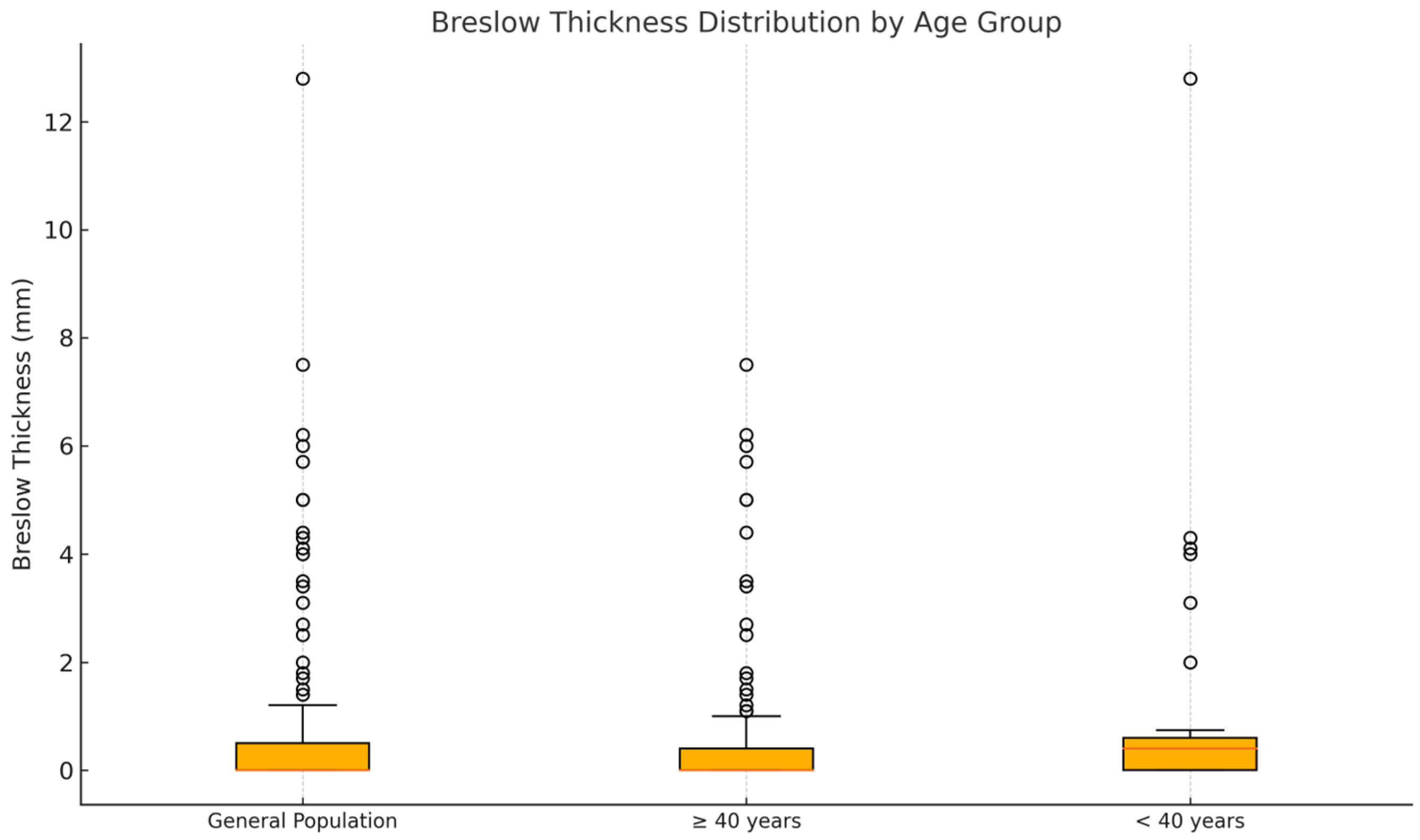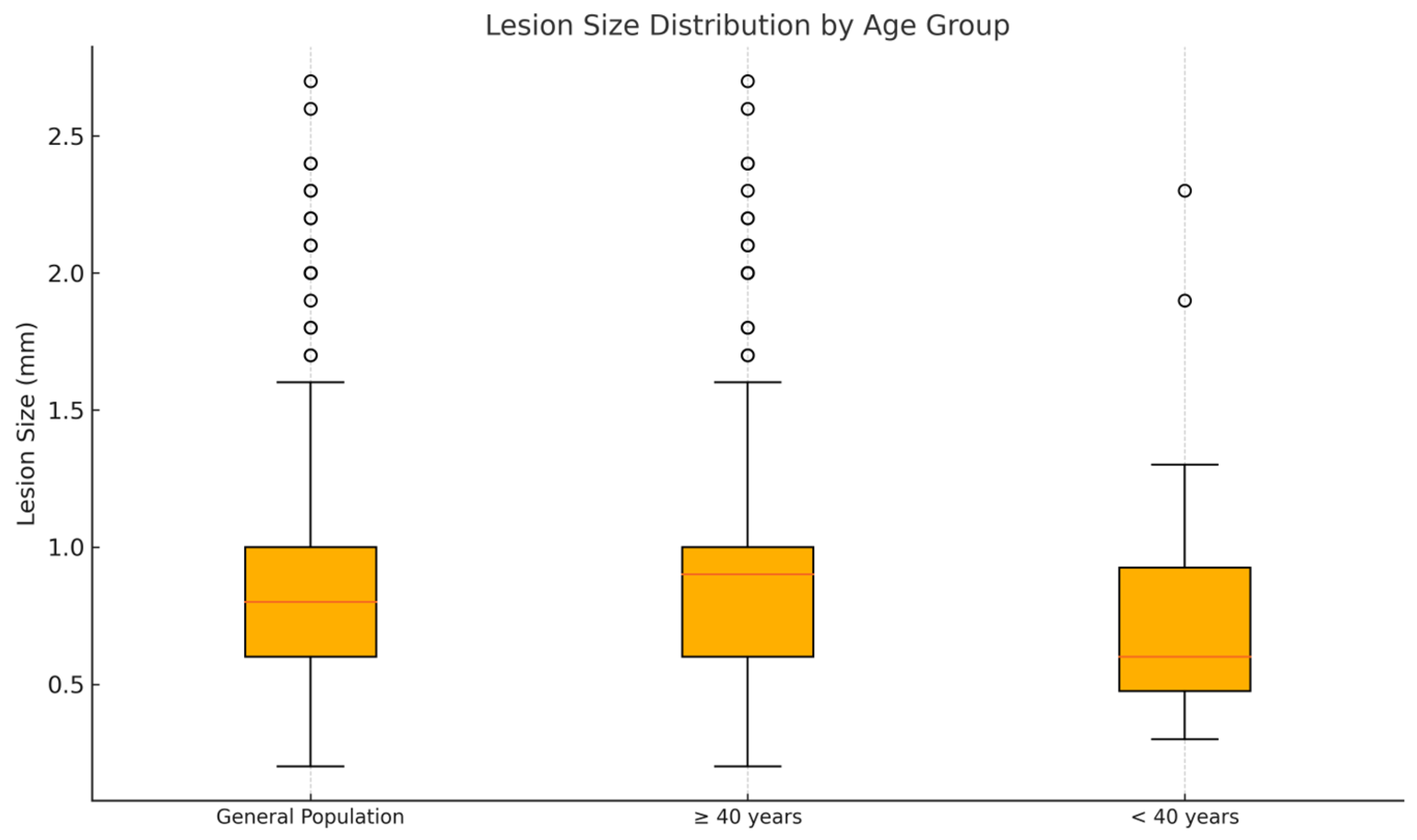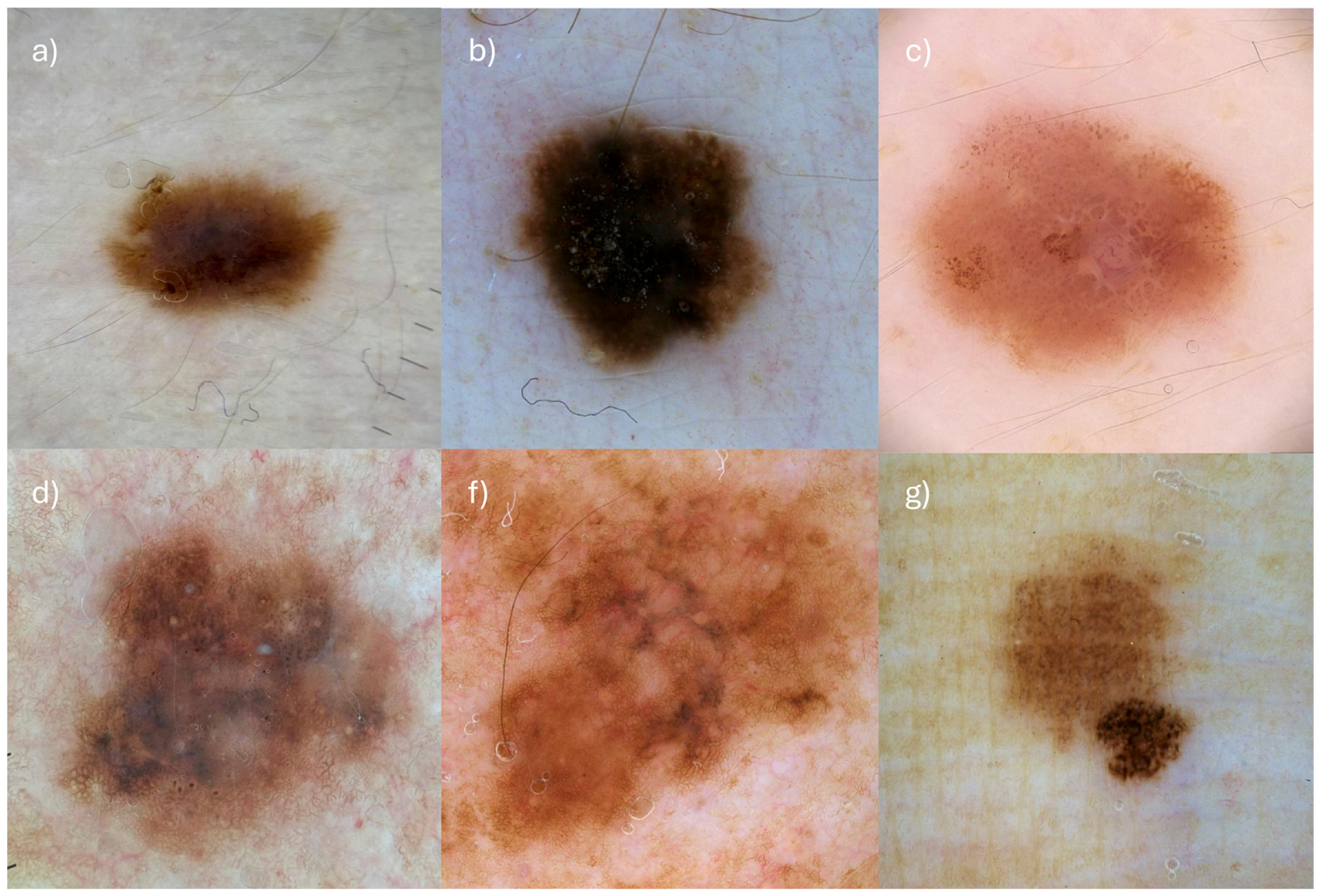The incidence of MM is rapidly increasing across Europe, affecting both in situ and invasive forms. This rise is attributed to multiple factors, including a genuine increase in incidence, as well as improved diagnostic accuracy facilitated by advanced non-invasive techniques such as dermoscopy, digital videodermoscopy, total-body photography, and confocal microscopy [
19]. Additionally, a certain degree of clinical and pathological overdiagnosis has been reported. A major debate in the scientific literature concerns the actual impact of enhanced diagnostic capabilities on melanoma-related morbidity and mortality [
13]. Despite the surge in diagnoses of in situ and minimally invasive melanomas, a proportional decrease in thick melanomas has not been observed. If early-stage melanomas were true precursors to advanced lesions, one would expect a decline in the incidence of thick melanomas. However, epidemiological data indicate that while the detection of thin melanomas has increased significantly, the incidence of thick melanomas has also risen. This paradox raises questions regarding the effectiveness of widespread population-based melanoma screening, shifting the focus towards targeted screening strategies [
20]. Current recommendations favor screening individuals at higher risk—those with a personal or family history of melanoma, fair skin, a high nevus count, dysplastic nevus syndrome, or signs of chronic sun damage—rather than indiscriminate population screening [
21,
22]. Given this perspective, refining risk stratification within the population is crucial to improving diagnostic accuracy and identifying high-risk lesions at an early stage. However, relatively few studies have investigated melanoma characteristics while stratifying patients by age. Currently, data on the clinical, pathological, and prognostic features of MM in individuals under 40 years of age remain inadequate. This gap is partly because melanoma is more prevalent in individuals over 40 [
12]. The limited epidemiological studies based on cancer registries suggest that melanoma in younger individuals exhibits distinct epidemiological, clinical, and prognostic features compared to that in middle-aged and older adults. Specifically, in younger patients, melanoma appears to have a female predominance (potentially influenced by estrogenic factors and sun exposure patterns), a predilection for the trunk and lower extremities, a higher frequency of the spitzoid histological subtype, and a relatively better prognosis [
2,
23,
24]. It is important to recognize that our study sample is not fully representative of the general population, as it was derived from a secondary referral dermatology clinic where patients were evaluated for lesions of uncertain interpretation. Despite this limitation, our findings align with existing literature in certain aspects, such as the different anatomical distribution of melanoma between younger and older individuals. In older patients, MM is more frequently observed in chronically sun-exposed areas, such as the face and upper limbs, and exhibits a lentiginous and regressive appearance. To our knowledge, this is the first study to specifically analyze age-related variations in the expression of melanoma-specific dermoscopic criteria. A previous study by Slowinska et al. examined differences in risk factors and general dermoscopic patterns (e.g., multicomponent, spitzoid, amelanotic) across three age groups (<30 years, 30–60 years, >60 years) but did not conduct an in-depth analysis of validated melanoma-specific dermoscopic criteria [
25]. Nevertheless, their findings highlighted significant age-related dermoscopic differences, with younger patients (<30 years) more frequently exhibiting spitzoid lesions, while older patients (>60 years) presented with lesions displaying lentiginous and regressive features [
25]. Our findings support these observations, showing that younger patients tend to have melanomas with a higher prevalence of growth-associated features (e.g., atypical globules/dots, pseudopods) and a more homogeneous pattern, contributing to a spitzoid appearance. In contrast, older patients more frequently display regressive dermoscopic features (e.g., scar-like depigmentation, peppering), resulting in a high frequency of melanomas with a lentiginous appearance and asymmetry of color. The presence of asymmetrical globules or dots was significantly more frequent in the younger patient group (55.6% vs. 34.9%), consistent with dermoscopic features indicative of tumor growth and proliferation. This finding aligns with the observed higher prevalence of spitzoid and growth-associated patterns in younger individuals. Conversely, peppering was more commonly detected in older patients (38.2% vs. 19.4%), likely reflecting cumulative UV exposure and a more chronic, fibrotic regression process typical of aged skin. A particularly significant finding in our study is the observed difference in mean Breslow thickness between the two age subgroups. Patients under 40 years of age showed a mean Breslow thickness greater than 1 mm, a value significantly higher compared to that observed in the older subgroup. This difference could be partially attributed to a small number of extreme values influencing the mean (as suggested by the coinciding median values in both groups) and to the heterogeneous sample size. A limitation of the present study is the uneven distribution of the sample across age groups, with a substantially smaller number of patients under 40 years compared to the older cohort (36 vs. 249). This imbalance reflects the actual epidemiological prevalence of melanoma, which is less common in younger populations. Nevertheless, the analysis revealed a statistically significant difference in Breslow thickness between the two groups (
p = 0.011), indicating a genuine difference in the clinical behavior of melanoma in younger patients. These findings support the hypothesis that melanoma in younger individuals may present with distinct biological and clinical characteristics, such as greater thickness at diagnosis, warranting further investigation in larger and more targeted cohorts. However, it also raises the possibility that a subset of biologically aggressive melanomas in younger patients may be more challenging to diagnose due to their distinct dermoscopic presentation, ultimately impacting prognostic factors in this age group. Another relevant finding emerging from our study is the significantly larger lesion size observed in patients aged 40 years or older (mean size = 0.91 cm). This observation, seemingly in contrast with the greater mean Breslow thickness detected in younger patients, may reflect increased clinical detectability due to a more expansive superficial growth pattern. Conversely, melanomas in younger patients appear to exhibit a more aggressive behavior, despite maintaining smaller dimension (mean size = 0.73 cm). In our cohort, the presence of dermoscopic regression—defined according to established criteria in the literature as scar-like depigmentation and peppering—was identified as a significant predictor of histopathological regression. Univariate logistic regression analysis revealed a statistically significant association between scar-like depigmentation and histological regression (
p = 0.0013), with an OR of 2.8 (95% CI: 1.49–5.22). Similarly, peppering was significantly associated with histological regression (
p = 0.0018), yielding an OR of 2.6 (95% CI: 1.43–4.83). Taken together, the results indicate that melanomas exhibiting dermoscopic signs of regression have nearly a threefold increased likelihood of concurrent histopathological regression. Importantly, our study confirms the well-established correlation between dermoscopic regression features and their histological counterparts, as previously reported in the literature and supported by daily clinical practice. Moreover, we explored an additional discriminative factor: the age of the patient at the time of melanoma diagnosis. Our results demonstrated a differential predictive value of dermoscopic regression patterns across age groups. Although both peppering and scar-like depigmentation were more frequently observed in patients aged ≥40 years, peppering was significantly associated with histopathologic regression exclusively in younger patients (<40 years), whereas scar-like depigmentation retained predictive value only in the older group (≥40 years). This finding aligns with existing literature, which associates peppering with inflammatory-type regression, characterized histologically by dense lymphocytic infiltrates, dermal melanophages, and reduced epidermal melanocytes—features typical of early, immune-mediated melanoma regression, possibly more active in younger individuals. Conversely, scar-like depigmentation has been linked to fibrotic regression, with histological hallmarks such as dermal fibrosis, epidermal atrophy, and solar elastosis, more commonly seen in chronically sun-exposed skin of older patients [
21]. These age-related differences suggest that peppering and scar-like depigmentation may reflect distinct phases or pathways of the regression process, influenced by host immune competence and cumulative UV exposure. This supports the need for an age-aware interpretation of regression features in dermoscopic assessment and melanoma prognostication. [
26]. In this context, it is worth highlighting a case–control study by De Giorgi et al. on thin melanomas, which reported that dermoscopic regression may indicate a metastatic potential of the neoplasm [
27]. Furthermore, a retrospective analysis by Slowinska et al. investigating clinical, dermoscopic, and histopathological features of melanoma found that these characteristics—particularly those associated with regression—vary significantly with age [
25]. Inflammatory regression features, including peppering, were notably more frequent in younger patients. A possible pathophysiological explanation for these age-related differences may lie in the immunological variations across age groups. Younger individuals likely possess a more robust immune response, which could result in acute inflammatory activity against the neoplasm. Clinically, this manifests as peppering; histologically, as dense perilesional infiltrates of lymphocytes and melanophages. In contrast, older patients may exhibit a more attenuated or chronic immune response, promoting fibrotic remodeling and lesion involution, seen clinically as scar-like depigmentation and histologically as late-stage fibrotic regression. A relevant biological factor that may modulate MM development and progression in relation to age is the role of reactive oxygen species. Aging is associated with increased oxidative stress and diminished antioxidant defenses, promoting DNA damage and carcinogenesis [
28,
29]. Conversely, younger individuals may benefit from more effective immune surveillance and different redox environments, potentially explaining variations in melanoma behavior [
30]. Age-stratified logistic regression analysis in our cohort further confirmed the variable predictive performance of dermoscopic markers across age groups. Scar-like depigmentation was not a significant predictor of histological regression in patients under 40 years of age (
p = 1.00), while the association remained statistically significant in the ≥40 age group (
p = 0.0016), suggesting that a subset of histological regression in younger individuals may not be captured by dermoscopy. In contrast, peppering retained its predictive value in younger patients (
p = 0.015) but lost statistical significance in the older patients (
p = 0.079). To our knowledge, this is the first study to directly correlate dermoscopic regression features with histopathological regression while highlighting the influence of patient age. These findings offer novel insights into the biology of melanocytic regression and underscore the importance of personalized interpretation of regression features in melanoma diagnostics and prognostication. Further large-scale investigations are warranted to validate our preliminary findings and better characterize the melanoma profile in younger patients, a demographic that remains underrepresented in the current literature. We emphasize the importance of educating young individuals on melanoma risk factors (e.g., inadequate sun protection) and encouraging prompt dermatological evaluation in cases of newly developing lesions or changes in pre-existing lesions. We believe that self-monitoring plays a more crucial role in detecting high-risk lesions in this age group than generalized population-based screening. In the future, artificial intelligence and teledermatology may help reduce the current barriers to timely dermatological assessment, ultimately improving early melanoma detection in younger patients, particularly for the rare but clinically deceptive invasive lesions.









